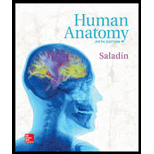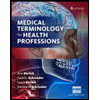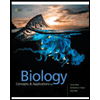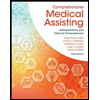
Human Anatomy
5th Edition
ISBN: 9780073403700
Author: Kenneth S. Saladin Dr.
Publisher: McGraw-Hill Education
expand_more
expand_more
format_list_bulleted
Concept explainers
Question
Chapter 3, Problem 3.3.17AYLO
Summary Introduction
To analyze:
The two principal constituents of blood and to determine the differences between three types of formed elements of blood.
Introduction:
Blood is considered as connective tissue because protein fibers appear in blood clots. Another factor is that the blood is produced by the connective tissues of the bone marrow and lymphatic organs.
Expert Solution & Answer
Want to see the full answer?
Check out a sample textbook solution
Students have asked these similar questions
Despite two individuals having high BMI with similar values, one person is more susceptible to cardiovascular disease than the other. This persons's obesity is known as
Group of answer choices
genetic obesity
dietary obesity
android obesity
gynoid obesity
It is generally believed that earlier adaptation to cold would affect survival in hypoxia. This effect is known as-
Group of answer choices
habituation
negative acclimatization
positive acclimation
accommodation
How is convection altered in a hot sauna room? What would be the net heat exchange? Use appropriate formula to explain.
Chapter 3 Solutions
Human Anatomy
Ch. 3.1 - Define tissue and distinguish a tissue from a cell...Ch. 3.1 - Prob. 2BYGOCh. 3.1 - Prob. 3BYGOCh. 3.1 - Prob. 4BYGOCh. 3.1 - Prob. 5BYGOCh. 3.2 - Distinguish between simple and stratified...Ch. 3.2 - Answer the following questions to test your...Ch. 3.2 - Prob. 8BYGOCh. 3.2 - Prob. 9BYGOCh. 3.2 - Prob. 10BYGO
Ch. 3.2 - Explain how urothelium is specifically adapted to...Ch. 3.3 - When the following tissues are injured, which do...Ch. 3.3 - Prob. 12BYGOCh. 3.3 - Prob. 13BYGOCh. 3.3 - Prob. 14BYGOCh. 3.3 - Prob. 15BYGOCh. 3.3 - Discuss the difference between dense regular and...Ch. 3.3 - Describe some similarities, differences, and...Ch. 3.3 - What are the three basic kinds of formed elements...Ch. 3.4 - Although the nuclei of a muscle fiber are pressed...Ch. 3.4 - What do nervous muscular tissue have in common?...Ch. 3.4 - What are the two basic types of cells in nervous...Ch. 3.4 - Name the three kinds of muscular tissue, describe...Ch. 3.5 - Distinguish between a simple gland and a compound...Ch. 3.5 - Prob. 23BYGOCh. 3.5 - Prob. 24BYGOCh. 3.5 - Prob. 25BYGOCh. 3.6 - What functions of a ciliated pseudostratified...Ch. 3.6 - Tissues can grow through an increase in cell size...Ch. 3.6 - Distinguish between differentiation and...Ch. 3.6 - Distinguish between regeneration and fibrosis....Ch. 3.6 - Prob. 29BYGOCh. 3 - Prob. 3.1.1AYLOCh. 3 - Prob. 3.1.2AYLOCh. 3 - Prob. 3.1.3AYLOCh. 3 - Prob. 3.1.4AYLOCh. 3 - Prob. 3.1.5AYLOCh. 3 - Prob. 3.1.6AYLOCh. 3 - Prob. 3.1.7AYLOCh. 3 - Prob. 3.2.1AYLOCh. 3 - The location, composition, and functions of a...Ch. 3 - Epithelial Tissue (p. 56) The defining...Ch. 3 - Prob. 3.2.4AYLOCh. 3 - The appearance, representative locations, and...Ch. 3 - Prob. 3.2.6AYLOCh. 3 - Differences in structure, location, and function...Ch. 3 - The process of exfoliation and a clinical...Ch. 3 - Prob. 3.3.1AYLOCh. 3 - Prob. 3.3.2AYLOCh. 3 - The types of connective tissue classified as...Ch. 3 - Prob. 3.3.4AYLOCh. 3 - The distinction between loose and dense fibrous...Ch. 3 - The appearance, representative locations, and...Ch. 3 - The appearance, representative locations, and...Ch. 3 - Prob. 3.3.8AYLOCh. 3 - Prob. 3.3.9AYLOCh. 3 - The relationship of the perichondrium to...Ch. 3 - Prob. 3.3.11AYLOCh. 3 - Prob. 3.3.12AYLOCh. 3 - Prob. 3.3.13AYLOCh. 3 - Prob. 3.3.14AYLOCh. 3 - Prob. 3.3.15AYLOCh. 3 - Why blood is considered a connective tissueCh. 3 - Prob. 3.3.17AYLOCh. 3 - Prob. 3.3.18AYLOCh. 3 - The meaning of cell excitability, and why nervous...Ch. 3 - Prob. 3.4.2AYLOCh. 3 - Prob. 3.4.3AYLOCh. 3 - Prob. 3.4.4AYLOCh. 3 - The defining characteristics of muscular tissue as...Ch. 3 - Prob. 3.4.6AYLOCh. 3 - Prob. 3.4.7AYLOCh. 3 - The microscopio representative locations, and...Ch. 3 - Prob. 3.5.1AYLOCh. 3 - The distinction between exocrine and eadocrine...Ch. 3 - Prob. 3.5.3AYLOCh. 3 - Prob. 3.5.4AYLOCh. 3 - Prob. 3.5.5AYLOCh. 3 - Prob. 3.5.6AYLOCh. 3 - Glands and Membranes (p. 75) The distinctions...Ch. 3 - Prob. 3.5.8AYLOCh. 3 - The tissue layers of a mucous membrane and of a...Ch. 3 - The nature and locations of endothelium,...Ch. 3 - Prob. 3.6.1AYLOCh. 3 - The difference between differentiation and...Ch. 3 - Two ways in which the body repairs damaged...Ch. 3 - The meaning of tissue atrophy, its causes, and...Ch. 3 - Prob. 3.6.5AYLOCh. 3 - Prob. 3.6.6AYLOCh. 3 - Prob. 1TYRCh. 3 - Prob. 2TYRCh. 3 - Prob. 3TYRCh. 3 - A seminiferous tubule of the testis is lined with...Ch. 3 - Prob. 5TYRCh. 3 - Prob. 6TYRCh. 3 - Prob. 7TYRCh. 3 - Tendons are composed of _________ connective...Ch. 3 - The shape of the external ear is due to skeletan...Ch. 3 - The most abundant formed elements(s) of blood...Ch. 3 - Prob. 11TYRCh. 3 - Prob. 12TYRCh. 3 - Prob. 13TYRCh. 3 - Prob. 14TYRCh. 3 - Tendons and ligaments are made mainly of the...Ch. 3 - Prob. 16TYRCh. 3 - Prob. 17TYRCh. 3 - Prob. 18TYRCh. 3 - Prob. 19TYRCh. 3 - Prob. 20TYRCh. 3 - Prob. 1BYMVCh. 3 - Prob. 2BYMVCh. 3 - Prob. 3BYMVCh. 3 - Prob. 4BYMVCh. 3 - Prob. 5BYMVCh. 3 - State a meaning of each word element and give a...Ch. 3 - State a meaning of each word element and give a...Ch. 3 - State a meaning of each word element and give a...Ch. 3 - Prob. 9BYMVCh. 3 - Prob. 10BYMVCh. 3 - Prob. 1TOFCh. 3 - Prob. 2TOFCh. 3 - Prob. 3TOFCh. 3 - Prob. 4TOFCh. 3 - Prob. 5TOFCh. 3 - Prob. 6TOFCh. 3 - Prob. 7TOFCh. 3 - Prob. 8TOFCh. 3 - Prob. 9TOFCh. 3 - Prob. 10TOFCh. 3 - Prob. 1TYCCh. 3 - Prob. 2TYCCh. 3 - Prob. 3TYCCh. 3 - Prob. 4TYCCh. 3 - Prob. 5TYC
Knowledge Booster
Learn more about
Need a deep-dive on the concept behind this application? Look no further. Learn more about this topic, biology and related others by exploring similar questions and additional content below.Similar questions
- How have the Arctic Inuits (people living in the Arctic) been able to stay in such cold conditions for so long? List and explain your reasons.arrow_forwardRecently I saw an action movie where the kidnappers accidentally killed the business tycoon by immersing his face in ice water. What could be the cause of death in this case? Group of answer choices vasodilation of peripheral vessels restriction of limb movement cardiac arrhythmia inability to open the eyesarrow_forwardBesides lack of food, what are the other physiological conditions that exacerbate the effects of starvation in developing countries?arrow_forward
- 1. A few years back, the faculty in Biology department faced complete loss of their research labs and office space due to unexpected flooding. This was early in the morning when students had come on-campus for their classes and faculty were ready to start teaching. a. Briefly explain the pathway that would have been activated in this acute stress. b. Also, considering that it was a while before things resumed to normal, explain what the effects of chronic stress under such conditions were.arrow_forwardwhich produces such as Cellular Respiration begins with NAD+ which is broken down during, to make which produces which occurs in the in the presence of anaerobic respiration that is used in pyruvate that is used in aerobic respiration alcohol such as which produces which is used in the to make 32 ATP -which produces which occurs in the starting with which occurs in thearrow_forwardDay 3-A: Venn Diagram Directions: Using the Venn diagram, describe a pure substance using the properties of elements and compounds. Write only the letters corresponding to your responses. PURE SUBSTANCE ELEMENTS COMPOUNDS A. It is the simplest form of matter.. B. It cannot be separated into simpler components by chemical means. C. It is made by two or more elements combined. D. It serves as the building block of other substances. E. Examples are oxygen, hydrogen, carbon, and gold. F. It can be separated into simpler substances by chemical means. G. It is represented by a chemical formula. H. Examples are water, sugar, salt, and baking soda. 3arrow_forward
- Describe in details the two molecular processes in steroid and peptide actionarrow_forwardCan you choose one topic of interest associated with microbiology, human diseases and / or human health.arrow_forwardPatients identified as at risk for falling are the most likely to suffer an Unanticipated Physiological fallarrow_forward
arrow_back_ios
SEE MORE QUESTIONS
arrow_forward_ios
Recommended textbooks for you
- Understanding Health Insurance: A Guide to Billin...Health & NutritionISBN:9781337679480Author:GREENPublisher:Cengage
 Medical Terminology for Health Professions, Spira...Health & NutritionISBN:9781305634350Author:Ann Ehrlich, Carol L. Schroeder, Laura Ehrlich, Katrina A. SchroederPublisher:Cengage Learning
Medical Terminology for Health Professions, Spira...Health & NutritionISBN:9781305634350Author:Ann Ehrlich, Carol L. Schroeder, Laura Ehrlich, Katrina A. SchroederPublisher:Cengage Learning 
 Comprehensive Medical Assisting: Administrative a...NursingISBN:9781305964792Author:Wilburta Q. Lindh, Carol D. Tamparo, Barbara M. Dahl, Julie Morris, Cindy CorreaPublisher:Cengage Learning
Comprehensive Medical Assisting: Administrative a...NursingISBN:9781305964792Author:Wilburta Q. Lindh, Carol D. Tamparo, Barbara M. Dahl, Julie Morris, Cindy CorreaPublisher:Cengage Learning

Understanding Health Insurance: A Guide to Billin...
Health & Nutrition
ISBN:9781337679480
Author:GREEN
Publisher:Cengage

Medical Terminology for Health Professions, Spira...
Health & Nutrition
ISBN:9781305634350
Author:Ann Ehrlich, Carol L. Schroeder, Laura Ehrlich, Katrina A. Schroeder
Publisher:Cengage Learning




Comprehensive Medical Assisting: Administrative a...
Nursing
ISBN:9781305964792
Author:Wilburta Q. Lindh, Carol D. Tamparo, Barbara M. Dahl, Julie Morris, Cindy Correa
Publisher:Cengage Learning